by Mark Schultz
June 2021
After the pandemic recession shook up the labor market last year, Southeast Minnesota has settled back into a tight labor market. Employers are looking for workers and often are struggling to find them for a variety of reasons. This has been particularly true in the region's two most distinguishing industries: Health Care & Social Assistance and Manufacturing.
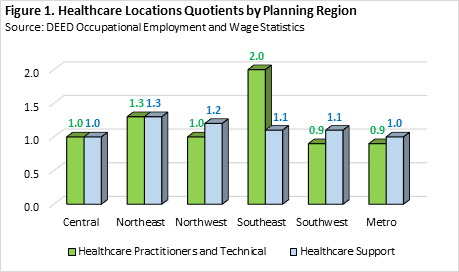 Of course, Southeast Minnesota is known for being a health care powerhouse, largely due to the presence of Mayo Clinic in Rochester, as well as other Mayo locations spread across the region. One data point that shows just how dominating health care is in the region is called a location quotient, which is a ratio that shows the concentration of a particular occupational or industry group compared to a reference category – in this case that reference category is the state as a whole. A location quotient over 1.0 shows a higher concentration of the particular occupational category compared to the reference category. As shown in figure 1, the location quotient for Healthcare Practitioners & Technical occupations is 2.0 in Southeast, dramatically higher than any of the other planning regions in the state. However, the location quotient for Healthcare Support occupations, while still over 1.0, is tied for third highest of all the regions in the state. Nonetheless, health care remains more highly concentrated in the Southeast region than the state as a whole. See Figure 1.
Of course, Southeast Minnesota is known for being a health care powerhouse, largely due to the presence of Mayo Clinic in Rochester, as well as other Mayo locations spread across the region. One data point that shows just how dominating health care is in the region is called a location quotient, which is a ratio that shows the concentration of a particular occupational or industry group compared to a reference category – in this case that reference category is the state as a whole. A location quotient over 1.0 shows a higher concentration of the particular occupational category compared to the reference category. As shown in figure 1, the location quotient for Healthcare Practitioners & Technical occupations is 2.0 in Southeast, dramatically higher than any of the other planning regions in the state. However, the location quotient for Healthcare Support occupations, while still over 1.0, is tied for third highest of all the regions in the state. Nonetheless, health care remains more highly concentrated in the Southeast region than the state as a whole. See Figure 1.
Health care occupations account for over one-fifth of the total employment in the region. This includes employment in Healthcare Practitioners & Technical occupations, such as Surgeons, Doctors, Nurses, Therapists, and Medical Technicians; as well as Healthcare Support, including Nursing Assistants and Home Health & Personal Care Aides; and also Medical & Health Services Managers. In fact, Healthcare Practitioners & Technical occupations alone is the largest employing occupational group in the region, making up 14.3% of the total regional employment. See Figure 2. However, it does not include Life Science occupations such as Biochemists, Microbiologists, Medical Scientists, and more; or Community & Social Service occupations, including Mental Health Counselors, Social Workers, Social & Human Service Assistants, and Rehabilitation Counselors.
Prior to the pandemic, the Southeast region was in the midst of a labor force shortage, with the ratio of jobseekers per vacancy getting as low as six job seekers for every 10 vacancies in the second quarter of 2019. While that ratio had increased to 2.3-to-1 in the second quarter of 2020 due to the shock of the pandemic recession, it again dropped in the 4th quarter of 2020 to 1.1-to-1. As a result, the region's employers are still struggling to fill their open positions.
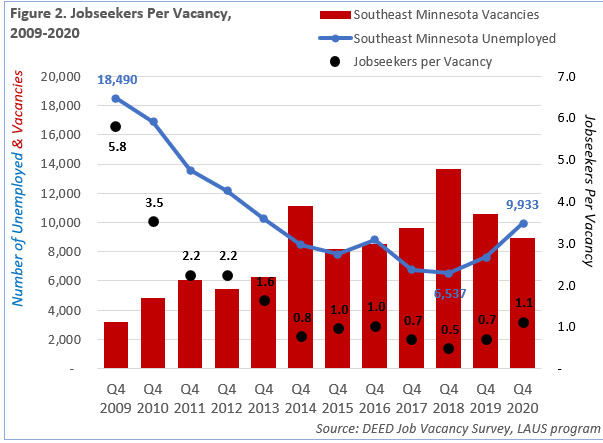
The number of new labor force participants in Southeast Minnesota has seen substantial decreases over the decades. From 1990 to 2000 there were, on average, 3,365 new workers per year. That number had dropped to 1,595 new workers per year during the following decade, meaning that the labor force was still growing, but that it was harder to find new workers for new jobs. With the big drop in 2020, this loss of new workers continued into the following decade, where the number of new workers per year dropped by 41.6%, with the addition of only 932 new workers per year. See Figure 3.
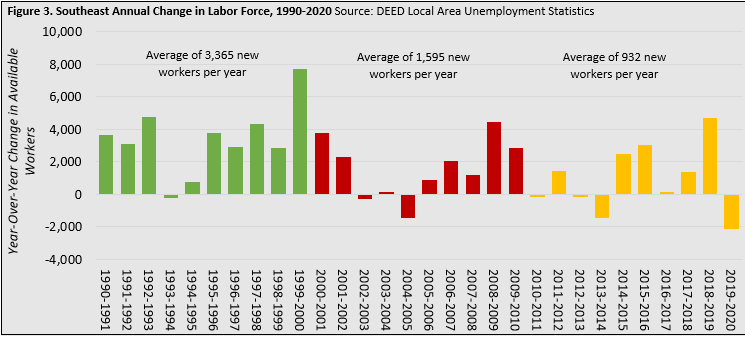
| Table 1. Southeast Minnesota Labor Force Projections, 2020-2030 | ||||
|---|---|---|---|---|
| Age Brackets | 2020 Labor Force Estimate | 2030 Labor Force Projection | 2020-2030 Change | |
| Numeric | Percent | |||
| 16 to 19 years | 17,287 | 15,562 | -1,725 | -10.0% |
| 20 to 24 years | 36,462 | 38,428 | +1,966 | +5.4% |
| 25 to 44 years | 100,054 | 102,738 | +2,684 | +2.7% |
| 45 to 54 years | 50,941 | 49,823 | -1,117 | -2.2% |
| 55 to 64 years | 52,914 | 40,385 | -12,529 | -23.7% |
| 65 to 74 years | 15,421 | 18,693 | +3,272 | +21.2% |
| 75 years & over | 2,971 | 4,304 | +1,333 | +44.9% |
| Total Labor Force | 276,050 | 269,934 | -6,116 | -2.2% |
| Source: calculated from Minnesota State Demographic Center population projections and 2015-2019 American Community Survey 5-Year Estimates | ||||
Due to the shifting population and the aging of the workforce, the region is projected to lose over 6,000 labor force participants from 2020 to 2030, a drop of 2.2%. The largest loss is projected among 55 to 64 year-olds, with a decline of over 12,500 or 23.7%. Additional, smaller losses are projected among the youngest age category as well as those between the ages of 45 and 54. As workers continue to age, naturally there are projected to be increases among those between the ages of 65 and over. However, there are also projected to be increases among younger workers between the ages of 20 to 44, just not enough to tackle the enormous loss among those ages 55 to 64 (see Table 1).
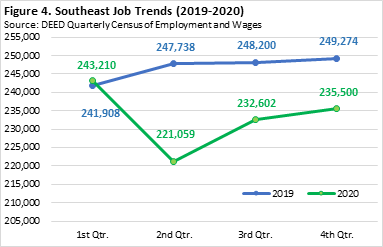 The pandemic had a strong impact on the region's job counts, resulting in a loss of over 22,100 jobs from the first to the second quarter of 2020, a drop of 9.1%. While the region experienced job gains the following two quarters, equaling a jump of over 11,500 jobs from the second to the third quarter and up by almost 2,900 jobs from the third to the fourth quarter, overall the region lost just over 7,700 jobs from the beginning to the end of the year. In comparison, the region experienced job gains during all quarters of 2019 (see Figure 4).
The pandemic had a strong impact on the region's job counts, resulting in a loss of over 22,100 jobs from the first to the second quarter of 2020, a drop of 9.1%. While the region experienced job gains the following two quarters, equaling a jump of over 11,500 jobs from the second to the third quarter and up by almost 2,900 jobs from the third to the fourth quarter, overall the region lost just over 7,700 jobs from the beginning to the end of the year. In comparison, the region experienced job gains during all quarters of 2019 (see Figure 4).
From the first to the second quarters of 2020, 16 of the region's 20 industry sectors lost jobs, including large losses in Accommodation & Food Services (-7,093 jobs), Health Care & Social Assistance (-4,068 jobs), and Manufacturing, Retail Trade, and Educational Services, each of which lost over 2,200 jobs. Conversely, 16 of the 20 industry sectors then regained jobs from the second to the third quarter, including large gains in Accommodation & Food Services (+4,205 jobs) and Retail Trade (+2,090 jobs). Finally, from the third to the fourth quarter, half of the industry sectors again saw job losses.
In all, throughout the course of the year, from the first to the fourth quarter of 2020, 13 of the 20 sectors lost jobs, with the highest overall losses experienced in Accommodation & Food Services (-3,918 jobs), Manufacturing (-1,968 jobs), Educational Services (-1,695 jobs), and Health Care & Social Assistance (-1,523 jobs). Agriculture, Forestry, Fishing & Hunting is the only industry sector that did not experience a loss of jobs throughout the year (see Table 2).
| Table 2. Southeast Job Trends - 2020 | ||||||||
|---|---|---|---|---|---|---|---|---|
| Industry Sector | Change in Jobs, Q1-Q2 | Change in Jobs, Q2-Q3 | Change in Jobs, Q3-Q4 | Change in Jobs, Q1-Q4 | ||||
| Numeric | Percent | Numeric | Percent | Numeric | Percent | Numeric | Percent | |
| Total, All Industries | -22,151 | -9.1% | 11,543 | 5.2% | 2,898 | 1.2% | -7,710 | -3.2% |
| Agriculture, Forestry, Fishing & Hunting | 291 | 9.8% | 79 | 2.4% | 22 | 0.7% | 392 | 13.2% |
| Mining | 88 | 87.1% | 27 | 14.3% | -26 | -12.0% | 89 | 88.1% |
| Construction | 1,006 | 11.3% | 549 | 5.5% | -734 | -7.0% | 821 | 9.2% |
| Manufacturing | -2,383 | -6.3% | 1,064 | 3.0% | -649 | -1.8% | -1,968 | -5.2% |
| Utilities | 7 | 0.5% | -33 | -2.5% | 3 | 0.2% | -23 | -1.7% |
| Wholesale Trade | -18 | -0.3% | -133 | -2.0% | -6 | -0.1% | -157 | -2.4% |
| Retail Trade | -2,310 | -9.0% | 2,090 | 8.9% | 684 | 2.7% | 464 | 1.8% |
| Transportation & Warehousing | -512 | -6.5% | -327 | -4.4% | 704 | 10.0% | -135 | -1.7% |
| Information | -342 | -11.2% | 11 | 0.4% | -25 | -0.9% | -356 | -11.6% |
| Finance & Insurance | -83 | -1.9% | 20 | 0.5% | -8 | -0.2% | -71 | -1.6% |
| Real Estate & Rental & Leasing | -111 | -7.8% | 88 | 6.7% | 12 | 0.9% | -11 | -0.8% |
| Professional, Scientific, & Technical Services | -234 | -6.9% | 60 | 1.9% | 1 | 0.0% | -173 | -5.1% |
| Management of Companies & Enterprises | -98 | -2.3% | 39 | 1.0% | 59 | 1.4% | 0 | 0.0% |
| Administrative Support & Waste Management | -407 | -5.6% | 706 | 10.3% | 1,646 | 21.8% | 1,945 | 26.8% |
| Educational Services | -2,201 | -10.6% | -2,335 | -12.6% | 2,841 | 17.6% | -1,695 | -8.2% |
| Health Care & Social Assistance | -4,068 | -6.1% | 1,816 | 2.9% | 729 | 1.1% | -1,523 | -2.3% |
| Arts, Entertainment, & Recreation | -1,512 | -40.5% | 1,458 | 65.6% | -790 | -21.5% | -844 | -22.6% |
| Accommodation & Food Services | -7,093 | -36.5% | 4,205 | 34.1% | -1,030 | -6.2% | -3,918 | -20.2% |
| Other Services (except Public Administration) | -1,788 | -27.4% | 1,223 | 25.9% | -110 | -1.8% | -675 | -10.4% |
| Public Administration | -383 | -3.6% | 937 | 9.1% | -426 | -3.8% | 128 | 1.2% |
| Source: DEED Quarterly Census of Employment and Wages | ||||||||
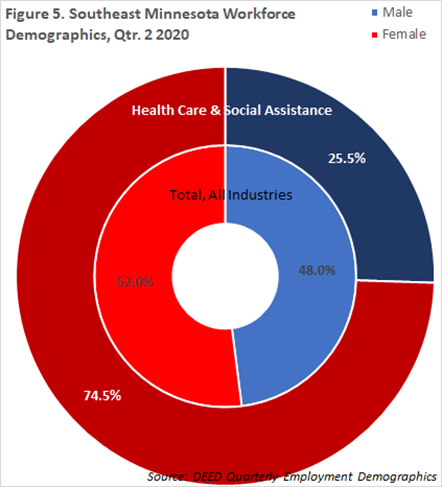 Southeast Minnesota's worker breakdown by gender reveals that there are slightly more women than men – 52% compared to 48%, respectively, as of the second quarter of 2020 (see Figure 5). This is the highest percentage of women workers of the six planning regions in the state and is 1.8 percentage points higher than that seen statewide, which is at 50.2%. This also reflects the region's higher employment levels in Health Care & Social Assistance, which is a female-dominated industry. In the second quarter, nearly three-fourths of the region's Health Care workforce was female.
Southeast Minnesota's worker breakdown by gender reveals that there are slightly more women than men – 52% compared to 48%, respectively, as of the second quarter of 2020 (see Figure 5). This is the highest percentage of women workers of the six planning regions in the state and is 1.8 percentage points higher than that seen statewide, which is at 50.2%. This also reflects the region's higher employment levels in Health Care & Social Assistance, which is a female-dominated industry. In the second quarter, nearly three-fourths of the region's Health Care workforce was female.
Despite making up a larger portion of the workforce, women earn lower wages than their male counterparts by working in jobs earning $2.27 less than males across all industries, a difference of 9.6% lower. This is the second highest the wage gap has been in the last decade. In addition, women work fewer hours than males by working 393 hours in the second quarter of 2020 compared to the 480 hours that men work, only compounding the wage discrepancy that exists – lower hourly wages and fewer hours equals less pay.
| Table 3. Workers by Age (2nd Qtr. 2010 & 2020) | ||
|---|---|---|
| Age Group | Percent | |
| 2010 | 2020 | |
| 19 and under | 7.3% | 6.5% |
| 20 to 24 years | 10.7% | 9.2% |
| 25 to 44 years | 40.1% | 41.5% |
| 45 to 54 years | 23.1% | 18.8% |
| 55 to 64 years | 14.7% | 18.5% |
| 65 and over | 4.1% | 5.5% |
| Source: DEED Quarterly Employment Demographics | ||
Due to the aging of the region's population, there have been some shifts in the make-up of the workforce by age. As shown in Table 3, the percentage of workers between the ages of 45 to 54 saw a significant drop, decreasing from 23.1% in 2010 to 18.8% in 2020, while additional declines were seen among those 24 and under. Conversely, those between the ages of 25 to 44, often termed the "prime working years" saw an increase, jumping from 40.1% in 2010 to 41.5% in 2020. In addition, the two oldest age categories also experienced significant increases as workers aged into these categories.
| Table 4. Workers by Race/Ethnicity (2nd Qtr. 2010 & 2020) | ||
|---|---|---|
| Race/Ethnicity | Percent | |
| 2010 | 2020 | |
| White | 94.2% | 90.6% |
| Black or African American | 2.1% | 4.0% |
| American Indian or Alaska Native | 0.3% | 0.4% |
| Asian | 2.6% | 3.7% |
| Two or More Race Groups | 0.8% | 1.3% |
| Hispanic or Latino | 3.7% | 5.5% |
| Source: DEED Quarterly Workforce Indicators | ||
Southeast Minnesota's workforce is relatively non-diverse, however it has become more diverse over time. As shown in Table 4, white workers made up 94.2% of the total workforce in 2010 while there were much lower representations among the remaining race categories. In comparison in 2020, just 10 years later, the percent of white workers had dropped to 90.6% while the remaining categories all saw increases. In addition, the percent of workers identifying as Hispanic or Latino also saw an increase, jumping from 3.7% in 2010 to 5.5% in 2020.
Southeast Minnesota's labor market landscape, known for its strong health care presence, has definitely seen some changes over time, some of which were positive while others could present challenges. In the long run, the region is seeing slower labor force growth and labor force projections show that this dwindling is likely to continue in upcoming years. Long-term demographic changes including age as well as race and ethnicity shifts, are resulting in a regional workforce getting older and more racially diverse. COVID-19 caused short-term changes with an unprecedented number of jobs lost in a short period of time followed by a gradual job recovery.